|
HEAVENLY TRASH
... the symbols of the divine initially show up at the trash stratum... (Philip K. Dick)
A programme that shows videoworks using influences and elements of trash art being referred to as style, strategy, fashion or statement or being used as inspriration.
Curated by Jan Schuijren, Amsterdam.
|
Kain Karawahn (GER); Magischer Schnittplatz (1994, 7'00)
An image of and from a videocamera being sawed in half grants an unspoken deathwish in this age of image overload.
Kain Karawahn (born 1959, living and working in Berlin) works with photography, video and fire-actions and performances world wide. He participated in the Dokumenta IX videoprogramme.
|
|
Bas van Koolwijk (NL); Five (2002, 3'00)
An entirely abstract video. Van Koolwijk’s work is very minimal and has a clear structure. The video images are stripped of their representation and sometimes limited to "a search for the balance between order and chaos". The sequences often erode the boundary between signal and a lack thereof. Power techno in image and sound.
Bas van Koolwijk, initially beginning his artistic career as a painter, soon found the medium too limiting to express the color and motion he envisioned. Upon receiving his degree from the School of Fine Arts Utrecht, he took up residence in Utrecht, NL, and began active experiments with the video format.
|
|
Michaela Schwentner (A); The Future of Human Containment (2002, 5'00)
Michaela Schwentner created images to accompany the track 'the_future_of_human_containment' by PURE, using various computer programs rather than a camera. A stylized enlargement makes identification impossible, a non-recognition which continues on the acoustic level. (Andrea Pollach)
Michaela Schwentner was born in 1970 in Linz, Austria, and studied philosophy, drama and media. Next to her work on visuals, she develops and produces concepts for exhibitons, concerts and clubs.
|
|
reMI (NL/A); Zikfijergijok (2003, 3'00)
Electronic excorcism? Computerized worldfire? Digital dance of the dead? The textual references in the videowork "Zikfijergijok" by dutch/austrian duo 'reMI' (Renate Oblak and Michael Pinter) initially point towards a religious apocalyps. These literal text and image shreds of traditional world knowledge are just good enough or charged enough to be fed into the great pixel revelation: abrupt and garishly flickering graphic patterns whose shrilly overmodulated microprocessed scratch sound relentlessly sweeps up everything projected under and over it into its digital Orcus. By the end of "zikfijergijok" our contemporary information stores (based on zeros, ones, vectors, electrical impulses, etc.) have been ground into so much electronic scrap just as mercilessly as the venerable encyclopedias of a bygone age. (Christian Höller)
The artistic collaboration between Renate Oblak (Austria) and Michael Pinter (Netherlands) started in 1998. They work with sound, video and computerart, presenting their work in screenings, exhibitions and performances world wide.
|
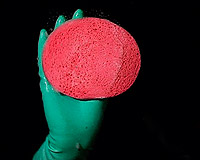 |
Anna Anders (GER); Cleaner Clip (2003, 1'50)
Three pairs of hands wearing yellow, red and turquoise-colored rubber gloves clean a pane of glass from behind, so that the viewer gets the impression that the real television screen is being cleaned from the inside. The cleaning process emerges into obsessive behaviour - into a cleaning madness or mania. While performing all imaginable cleaning techniques, a mixture of rubbing, scouring, scratching, squeaking, foaming and spraying sounds is created, reaching us in a dynamic range-change of rhythms and volumes.
|
|
Anna Anders, born 1959 in Munich (GER), living in Cologne, works with video (single-channel tapes and installations) since 1986, studied at
the Academy of Fine Arts Munich and at the Academy of Media Arts Cologne, from 1997-2001 assistant professor at the Academy of Media Arts Cologne.
|
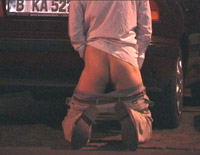
|
Joep van Liefland (NL/GER); Car Fuck (2000, 5'00)
A parking place in front of a suburbian appartment building, early in the morning. A man enters the scene and is seduced by the sight of a german car.
Joep van Liefland (NL/GER); Doggiedoggie (2001, 5'00)
About the dark side of male fears and emotions, the extasy of ugliness and the ultimate beauty of the snackbar.
|
|
Joep van Liefland sets his own images against the one dimensional cliches in film, TV and porno.
«Video, the failed film - Celluloid for the common man - Instant fastfood, eraseable - I love video».
Q: «Your work has references to the aesthetic of B-movies. Is this anti-aesthetic attitude or let's say the trash factor important to you?»
J.v.L.: «Very. We should worship the B. We should thank the B that it exists. B is the resevoir of the unspoiled and unexpected Beauty. There would be no mainstream without trash. Spielberg, Coen brothers etc., they all appeared through the 2 holes of the super-B».
|
|
Helmut Dick (GER/NL); Koffiezetapparaat (Coffee Machine) (1999, 1'10)
A man is urinating in a coffee- machine in order to water a catus.
Helmut Dick (GER/NL); Ballerina (2000, 1'30)
An erecting penis lifts up the lid of a musical box, a little balleria appears and starts dancing.
Helmut Dick was born in 1969 in Germany. He studied at the Free Media Dept. of the Rietveld Academy in Amsterdam and got his MA in Fine Arts at the Sandberg Institute in Amsterdam. He works with video and public space projects, and was nominated for Prix de Rome Sculpture 2003.
|
|
Pedro (F); Titanic (2001, 0'44)
What a wonderful world: A tribute to Charlie Chaplin. (P.)
Pedro (F); The Party (2001, 0'54)
What a wonderful world: The singers party is always joyfully happy. (P.)
Pedro (F); Only You (2001, 1'17)
"..that's merely some moments about a Home Star, a lonesome couple of singers.." (P.)
Pedro was born 1973 in France and graduated 2001 at the École Supérieur des Beaux Arts Grenôble. Works in installation, photography, video and painting, about "this wonderful sadness of life".
|
|
Joep van Liefland (NL/GER); Splatter Orgasm I - Sugar Pussy (2003, 1'26)
The “Splatter Orgasms” series (Splatter Orgasm I - Sugar Pussy; Splatter Orgasm II - Fountains of Love; Splatter Orgasm IV - City under Cum) are trailers for movies that will never be made. They form an hommage to the greatness of the little man and show his extraordinary performances. (J.v.L.)
Joep van Liefland (born 1966 in the Netherlands, living and working in Berlin) works with video, photography and installation, a.o. in public space.
|
|
Brian Doyle (USA); Current (2001, 6'00)
A digital wind blows the debris from an overflow of information through an abandoned metropolis. The city is consumed by this blanket of information. "While running around the crowded 2000 Yankees parade trying to keep people from kicking over my HI8, I was nearly engulfed in a whirlwind of tickertape debris set suddenly ablaze. This ended up becoming the film’s drive, its conclusion in implied destruction." (B.D.)
Brooklyn artist Brian Doyle received his MFA in Sculpture from the School of the Art Institute of Chicago. He makes "quasi-fictionalized documentaries and video installations as efforts to expose the forces and mechanisms of realities just out of the scope of our perception".
|
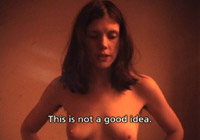
|
Emily Vey Duke,
Cooper Battersby (CAN); The Fine Arts (2002, 3'38)
"I hate the fine arts, I am disgusted by the fine arts, because, um, the fine arts are always made with artifice"
|
|
Cooper Battersby and Emily Vey Duke have been working collaboratively since 1994, resulting in printed matter, installation, curation and sound, but their primary practice is the production of single-channel video, which has won several prices and has been screened and exhibited throughout Europe and North and South America.
|
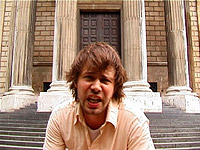
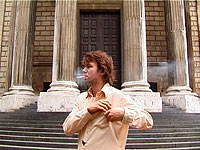
|
Jeroen Offerman (NL/UK/GER); The Stairway at St. Paul's (2002, 8'00)
The Stairway at St. Paul's' documents a performance by Jeroen Offerman, playing with the notion that in the 60-ies and 70-ies certain rock-and-roll recordings were supposed to contain hidden evil or satanic messages when played backwards. One of the most famous examples is Led Zeppelin''s 'Stairway to Heaven'. Offerman practiced for three months to learn perfectly how to sing this song backwards, went to St. Paul's Cathedral in London, a place frequently visited by tourists, to sing it standing in front of the stairway that leads up to the entrrance. The video is a live-registration of this event, but the tape is played reversed, so that the song and words can be heard 'normal' again.
«It's time to dive into your record-collection and find out if it all was true. But first let us watch this video. Turn up the volume and remember the first time you smoked a cigarette...» (J.O.)
|
|
Jeroen Offerman (born 1970, the Netherlands) received his BA in Fine Arts at St. Joost, Breda (NL) and his MA in Fine Arts at the Goldsmiths College, University of London. In between he did a performance workshop with the 'La Fura dels Baus' group. After living in London for the past 4 years he recently moved to Berlin.
|
total running time appr. 60
mins.
<<
BACK TO VIDEO PROGRAM
|